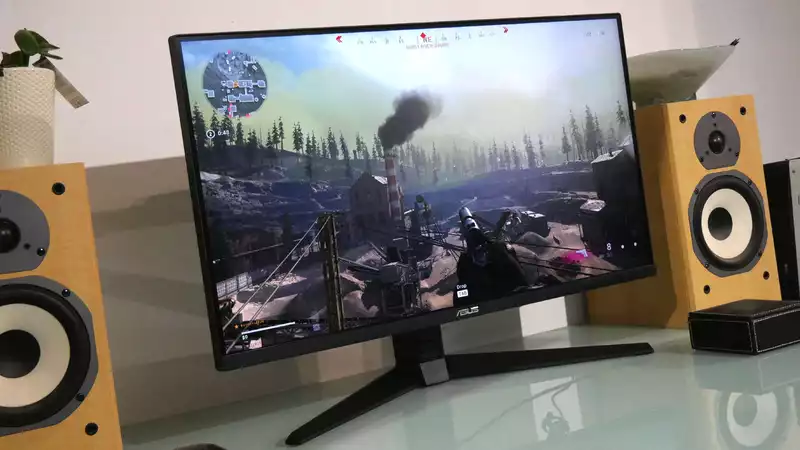4K native resolution, 144Hz refresh, IPS panel technology, HDR support, HDMI 2.1. what more could you ask for in a new Asus TUF Gaming VG28UQL1A as a multi-platform cutting edge gaming monitor? Maybe more affordable than previous panels that achieved similar goals." hold that thought.
Asus' latest monitor masterpiece is part of the TUF series of gaming goodies. In other words, not the premium Asus ROG line, but several lines that already offer a similar core feature set. This suggests affordability, at least in relative terms. But what about performance and features?
As for panel size, the Asus TUF Gaming VG28UQL1A actually adds an inch compared to the company's earlier 4K gaming monitors. While this is a 28-inch model, Asus now also offers a 32-inch 144Hz 4K model. We were a bit concerned about the 28-inch diagonal when we started this review. We have looked at several non-gaming 4K IPS monitors, including the Philips 288E2UAE and the Acer B287K, which are productivity-oriented sister titles, and they all shared at least slightly inferior still image quality in terms of vividness and saturation.
Anyway, one obvious limitation on the spec sheet is the VESA DisplayHDR 400 certification. This is entry-level HDR, meaning that this panel operates with a simple monolithic backlight. There is no local dimming, let alone the latest mini-LEDs, and Asus' claim of 90% coverage of the DCI-P3 digital cinema color space is also a relative limitation. HDR displays certified at higher levels tend to cover more than 95% of DCI-P3.
Nevertheless, the VG28UQL1A supports a maximum brightness of 450 nits, which exceeds the minimum HDR 400 requirement. More importantly, it is a very fast display on paper; Asus says it can achieve a pixel response of 1ms gray-to-gray, rather than the less demanding MPRT metric. It also supports the aforementioned 144Hz refresh rate and both Nvidia G-Sync and AMD FreeSync, but this is not a full G-Sync monitor with the required Nvidia modules. It simply supports G-Sync.
The final feature worth noting is HDMI 2.1 support, which, along with the DisplayPort 1.4 interface, means the Asus TUF Gaming VG28UQL1A can offer 4K high refresh gaming on both PC and console, although the latter limited to 120Hz instead of the full 144Hz. This monitor kind of promises everything, even with the debatable lack of true HDR capability.
Thankfully, the monitor also offers quite a bit in reality.
Contrary to our concerns about the current 28-inch 4K panel, this product is vibrant, punchy, and accurate in terms of basic image quality and color balance. The panel's static contrast is also decent, even if IPS monitors cannot compete with the best VA screens in the field.
It's also decently fast. As one would expect from a gaming monitor in this class, Asus has included user-configurable Pixel Overdrive. In the two fastest modes, overshoot is quite noticeable, resulting in reverse ghosting, but levels 2 and 3 provide a really sharp and racy response, with minimal overshoot.
Subjectively, the VG28UQL1A arguably rivals the best IPS panels in raw pixel response, and with the addition of 144Hz refresh, online shooters, battle royales, and other first-person jazz that benefit from a fast panel 240Hz is now common, 360Hz is available, and 480Hz is on the horizon. But unless you are particularly serious about esports, 144Hz should suffice.
At the same time, image detail and sharpness are the usual due to the 4K native resolution. You would have to be a very latency-sensitive person to give up eye candy for the slightest response time. If you want to enjoy a cyberpunk-like celebration of gaming graphics in all its ray-traced glory, you need a 4K panel like this one.
The only slight question mark is inevitably HDR performance. On the plus side, SDR content looks beautiful when the panel and Windows OS are in HDR mode. In other words, it is possible to run the full system in HDR mode. In addition, content, including the aforementioned cyberpunk, has a bit more depth and punch in HDR mode. However, the difference is slight and we would not classify this as a true HDR panel.
As a result, this is a strong all-rounder; the HDMI 2.1 interface is certainly a versatile panel for multi-platform gaming, even if there are questions about the realistic utility of 120Hz 4K gaming on the latest consoles.
Perhaps the more obvious caveat is that the HDMI 2.1 interface will inevitably increase costs. If one is only considering using this panel in a PC, the cost will bring little to no benefit. Our main concerns with the Asus TUF Gaming VG28UQL1A are
. Price. At £749 in the UK (the price in the US is not yet known, but will likely be around $800), it is not affordable enough to bring 4K high refresh to new users.
Now that something like a 4K, 120Hz LG OLED screen can be had for around £1,000/$1,000, such a screen looks especially low value. Not to make a direct comparison, but they are not flattering. The bottom line is that the masses will continue to wait for more accessible 4K, 144Hz gaming panels. Because, sadly, this is not it.
.

Comments